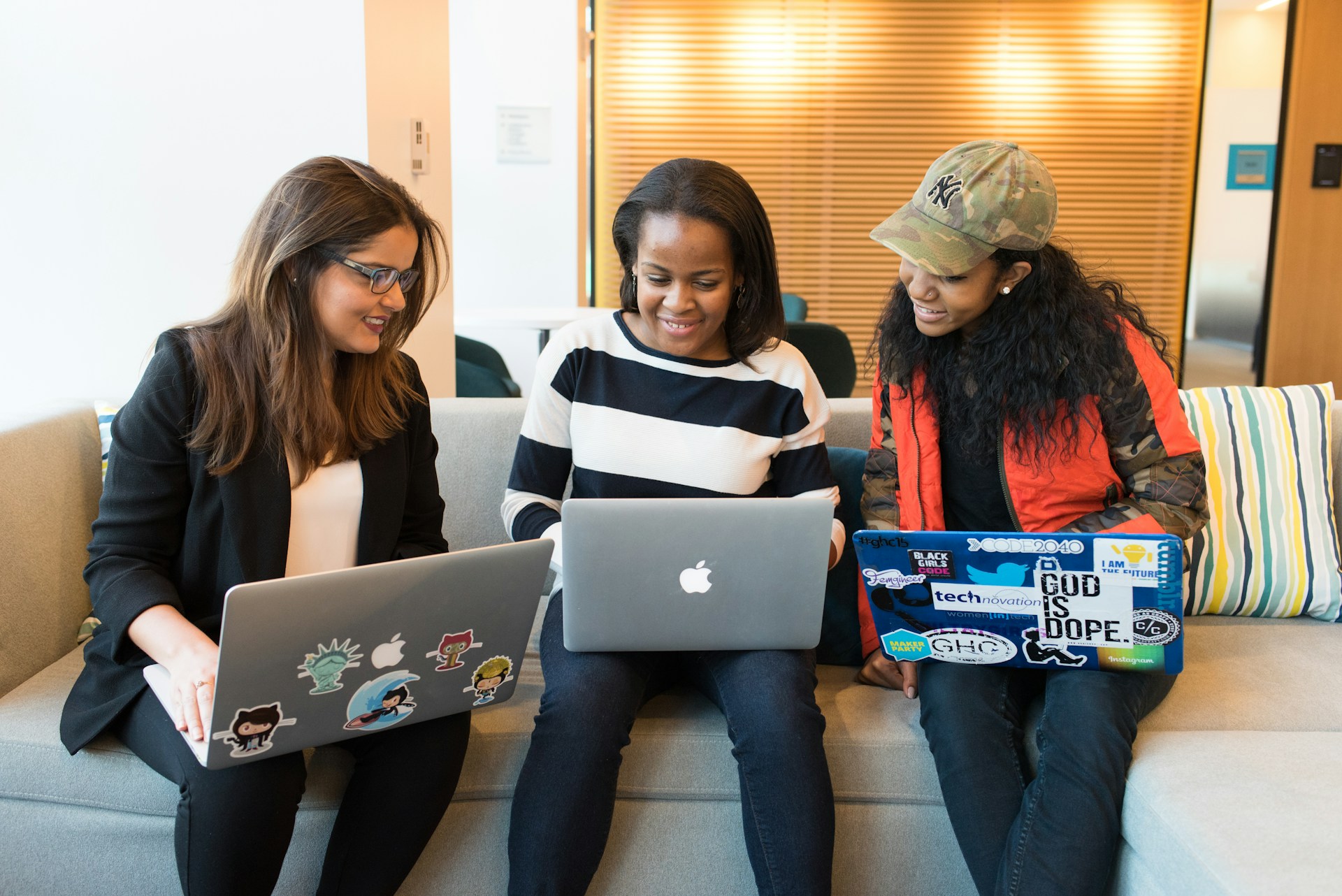
Article
Decoding Unconscious Bias and Promoting Diversity in Tech Hiring
05 Aug, 202411 minutes
Decoding Unconscious Bias and Promoting Diversity in Tech Hiring
Inclusivity and diversity in tech are currently prominent topics within the industry. Recent tech talent shortages and overall industry development have highlighted the need to diversify practices, with businesses taking a closer interest in fairer hiring practices.
But what happens when this aim and goal is met with unconscious bias? How do we decode this from just the sort of bias that every person has as a part of their human instinct and something that is directly impacting objectivity and diversity in tech within hiring?
In our previous discussions, we have explored how employers can promote diversity in tech, create a strong employer brand for women in tech, and redefine tech interview language for a more inclusive hiring process. In this guide, we will discuss unconscious bias in tech hiring, explore how it continues to impact the industry, and give your organisation strategies to combat it in hiring practices.
We will dive into the following:
- Understanding unconscious bias in tech hiring
- Top 4 strategies to combat unconscious bias
- Structured interviews
- Blind recruitment
- Diverse hiring panels
- Use of technology
Understanding Unconscious Bias in Tech Hiring
The whole concept of unconscious bias can be difficult to comprehend, especially as it manifests itself in multiple ways and various areas of the hiring process. Though we have discussed mitigating unconscious bias as a strategy in our guide on ‘how employees can promote diversity in their tech teams,’ it’s such an important but complex issue within the hiring process that it needs expansion.
Let's start by breaking it down.
What is Unconscious Bias?
Unconscious bias is the automatic and unintentional judgments or stereotypes individuals form about others based on their background, experiences, and societal influences. Unlike explicit bias, which is deliberate and conscious, unconscious bias operates subtly and often without our awareness, impacting our decisions and interactions.
Unconscious bias can show up in several forms, each affecting how we behave and make decisions:
- Affinity Bias: Favouring people who are similar to us in some way, like sharing the same interests or background.
- Gender Bias: Making assumptions about someone based on their gender.
- Racial Bias: Forming opinions about people based on their race or ethnicity.
- Age Bias: Judging people based on age, whether young or old.
- Confirmation Bias: Only pay attention to information supporting our beliefs and ignore anything that challenges them.
Our attitudes can affect our thoughts, feelings, and actions toward others. Employees are not robots; we all have different opinions that can influence our behaviour. Unconscious biases are often rooted in social stereotypes and shaped by our upbringing, beliefs, and past experiences. These biases can make us act in ways that reinforce existing stereotypes without us even being aware of them.
How is Unconscious Bias Impacting Your Working Environment and Hiring Processes?
Unconscious bias can significantly impact your workplace and hiring process, often in ways that aren't immediately obvious. One survey found that workers who experienced bias were 33% more likely to feel alienated and 34% more likely to withhold ideas. This shows that bias affects individuals' sense of belonging and stifles innovation and open communication.
In tech recruitment, unconscious bias can subtly influence hiring decisions, leading to less diverse and inclusive teams. For example, affinity bias might lead hiring managers to favour candidates who share similar educational backgrounds or professional experiences, reducing the chances of selecting a diverse range of candidates. Various forms of bias can result in the underrepresentation of different groups, perpetuating imbalances in the industry.
Specific examples of bias affecting diverse groups in tech include:
- Resume Review: Resumes with names that suggest a particular gender or ethnicity are often less likely to get callbacks than identical resumes with more familiar names.
- Interviews: People from different backgrounds might be judged more harshly for behaviours seen positively in others, like assertiveness in women or enthusiasm in younger candidates.
- Performance Evaluations: Bias can also appear in performance reviews, where individuals from underrepresented groups may receive less credit for their achievements.
Why Addressing Unconscious Bias Matters
If left unchecked, unconscious bias can harm team diversity in tech and overall company performance. A lack of diversity in tech has the potential to lead to a homogeneous work environment where creativity and innovation suffer. On the other hand, diverse teams bring various perspectives and ideas, supporting a more innovative and adaptable company environment.
Consequences of Unchecked Bias:
- Reduced diversity in tech: Teams that are too similar are less likely to challenge each other’s ideas, leading to less creativity.
- Lower Employee Morale: Employees who feel excluded or unfairly treated are more likely to disengage and eventually leave, increasing turnover rates.
- Damaged Company Reputation: Companies known for biased practices may need to help attract top talent, which could affect their competitive edge.
Benefits of Diverse Teams in Tech:
- Enhanced Creativity and Innovation: Diverse teams bring different perspectives, leading to more creative solutions and products.
- Better Decision Making: Various viewpoints can improve decision-making, as diverse teams are more likely to consider a broader range of options.
- Improved Employee Satisfaction and Retention: An inclusive environment where diverse perspectives are valued leads to higher job satisfaction and lower turnover rates.
- Stronger Company Reputation: Companies known for their diversity in tech and inclusion efforts can attract top talent and stand out in a competitive market.

Top 4 Strategies to Combat Unconscious Bias Within Hiring
Now that we have discussed the true meaning of unconscious bias, how it manifests itself, and its impact on the tech recruitment process and internal team dynamics, there are multiple ways to combat it in hiring practices within tech environments. Let’s discuss these.
1. Structured Interviews
By definition, unconscious bias occurs when we act on stereotypical assumptions without conscious awareness. To mitigate this, it is essential to make the interview process as structured as possible. A structured interview process reduces the impact of unconscious bias by ensuring that all candidates are evaluated based on the same criteria.
A study found that structured interviews accounted for 26% more variance in hiring decisions than unstructured interviews, leading to better hiring outcomes. Structured interviews help to level the playing field by ensuring that each candidate is assessed equally and fairly.
Here are some examples of how you can implement a structured interview process tailored explicitly to tech hiring:
- Develop Specific Interview Questions: Focus on technical skills, problem-solving abilities, and coding expertise relevant to the tech role. Tailor questions to the specific technologies mentioned in the job description.
- Commit to a Limited Time for Each Section: This keeps the interview focused, ensures all areas are covered, and helps maintain consistency across all interviews.
- Standardise Scoring with a Rubric: Outline desired responses and assign points for each question. Focus on technical concepts, problem-solving steps, or coding best practices.
- Train Interviewers: Educate them on the interview format and scoring system. Train them on how to probe for insights without introducing bias.
- Focus on Skills and Experience: Frame questions around the candidate's abilities and past projects, not personal characteristics. Ensure the evaluation is based on relevant skills and experiences rather than subjective impressions.
Consistency in Questioning
Using the same questions for all candidates is essential for maintaining consistency. This practice ensures that every candidate is evaluated on the same criteria, making the process fairer and reducing potential bias. When all candidates face the same questions, it provides a level playing field and makes comparing candidates more objective.
Example:
Prepare standard interview questions and ensure each interviewer uses them, recording responses to compare candidates fairly. For instance, if you are hiring for a software development position, you might include questions about specific programming languages, problem-solving scenarios, and past coding projects. By recording responses and scoring them against a standardised criteria, interviewers can objectively compare the qualifications and skills of each candidate.
Implementing these strategies can create a more inclusive and equitable interview process. A thorough, structured, and fair method of interviewing will help your organisation attract and retain a varied and talented tech workforce.
2. Blind Recruitment
Blind recruitment is another fundamental way to minimise unconscious bias during the tech hiring process. This approach helps ensure a fairer evaluation of candidates by focusing solely on their skills and qualifications rather than on potentially bias-inducing personal information.
Blind hiring software like GapJumpers has been shown to significantly increase the chances of minority and female applicants being offered first-round interviews—by approximately 40% compared to standard resume screening. Such software anonymises resumes, removing identifiers such as names, genders, and sometimes even educational institutions and addresses. This allows recruiters to decide based only on the applicant's qualifications and experience.
However, it is essential to note that blind hiring typically only masks candidate information during the early screening stages. Once candidates move to face-to-face interviews, biases based on visible characteristics can still come into play. Despite this limitation, blind hiring offers many benefits, including:
- Increased Likelihood of Women Being Hired: Research indicates that blind hiring processes can increase the likelihood of women being hired by 25-46%.
- Reduction in Callback Disparities: Research indicates that resumes with names perceived as white receive 50% more callbacks for interviews than identical resumes with names typically associated with Black individuals. Implementing blind recruitment can help address these disparities.
- Enhanced Diversity in Tech: By reducing unconscious bias, blind recruitment supports the creation of a more diverse tech team, which can lead to greater innovation and problem-solving capabilities.
- Fair Evaluation of Tech Talent: Blind hiring ensures that the best tech talent is identified and considered, regardless of background, by focusing on skills and qualifications.
To effectively implement blind recruitment and reduce unconscious bias in your tech hiring practices, consider the following strategies:
- Remove Identifying Information from Resumes: Ensure that resumes are stripped of names, genders, addresses, and other personal details that could trigger unconscious bias.
- Create a Standardised Screening Process: Develop a consistent set of criteria and questions for evaluating all candidates, ensuring that decisions are based solely on merit and relevant qualifications.
- Anonymise Initial Communications: Use coded identifiers for candidates in initial communications and evaluations to maintain anonymity until later stages of the hiring process.
- Blind Review Panels: Assemble review panels that assess anonymised applications independently, ensuring that multiple perspectives are considered without being influenced by personal information.
By adopting these strategies, your business can effectively implement blind recruitment, helping to reduce unconscious bias and promote a more inclusive and diverse hiring process in the tech industry. This, in turn, strengthens your tech team and enhances your ability to attract and retain top tech talent.
3. Diverse Hiring Panels
Unconscious bias can easily creep into the hiring process, especially when interviewers and recruiters come from similar backgrounds. This shared background can unknowingly influence their decisions. In the tech industry, where diversity is a key driver of innovation, addressing and mitigating these biases is crucial to ensure a fair and inclusive hiring process.
Your recruiters reflect your company’s vision. In tech, this vision must include a solid commitment to inclusivity and eliminating bias. Recruiters might not always be aware of their biases, but these unconscious biases can significantly impact their decisions. One effective way to counteract this is by implementing diverse hiring panels.
Diverse hiring panels bring several benefits to the table, especially in the tech industry:
- Broader Range of Insights: When people from different backgrounds come together, they bring unique perspectives and experiences, leading to a deeper understanding of each candidate's potential.
- Different Evaluation Criteria: Diverse panel members might value different skills and attributes, offering a more well-rounded evaluation of candidates.
- Challenge Assumptions: A diverse group is more likely to question and challenge any biases, making sure that unconscious biases are brought to light and addressed.
- Enhanced Decision-Making: With diverse voices in the discussion, hiring decisions are more thorough and balanced, considering multiple aspects of each candidate.
Unconscious bias happens when we unknowingly favour specific candidates over others based on stereotypes or personal experiences. This bias can skew the recruitment process, resulting in a lack of diversity in tech teams. By having diverse hiring panels, you can minimise these biases and create a more inclusive hiring environment.
You can incorporate diverse hiring panels into your recruitment process in several ways. Let’s discuss some practical steps below.
Ensure Diversity in Tech Panels
Include a mix of genders, ethnicities, and backgrounds in your hiring panels. For example, if your tech team lacks gender diversity, ensure women are represented on the interview panel. Diverse hiring panels mirror the variety of candidates you aim to attract, which is crucial for building a talented and varied tech workforce.
Provide Unconscious Bias Training:
Train all panel members on unconscious bias and its impact on recruitment decisions. Use real-life examples of unconscious bias in recruitment to show how these biases can appear and affect decision-making. This training can help interviewers recognise and counteract their own biases.
Encouraging Different Perspectives
Actively seek out and value different viewpoints during the evaluation process. Make sure all panel members feel comfortable sharing their unique insights and experiences. Diverse panels are more likely to challenge assumptions and prevent unconscious biases from going unchecked, leading to a more balanced assessment of candidates.
Implementing these strategies can create a more inclusive and equitable recruitment process. Diverse hiring panels help reduce unconscious bias and ensure that the best tech talent is selected based on a comprehensive and fair evaluation. This approach will contribute to building a diverse team to drive innovation and success within your business
4. Use of Technology
When discussing ways to limit unconscious bias in tech hiring, it is only fitting to mention how technology can play a crucial role in enabling and supporting this effort. As unconscious bias is typically attributed to humans, more businesses are using technology, AI-powered hiring tools, and other applicant tracking systems to reduce internal biases and ensure a fairer hiring process for all tech professionals.
Using technology in your hiring process can bring many benefits for a business looking to mitigate unconscious bias. Here are some ways it can help:
- Blind Hiring Software: As previously discussed, tools like GapJumpers can anonymise candidate information during the initial screening stages. Removing names, genders, and other personal details helps ensure that candidates are judged solely on their skills and experience.
- AI and Machine Learning Tools: Platforms like HireVue use algorithms to screen candidates impartially. These tools analyse various aspects of a candidate’s application, focusing on qualifications and relevant experience without being influenced by factors like name or appearance.
- Bias Detection in Job Descriptions: Platforms like Textio monitor and analyse job descriptions and communications to detect and correct biased language. This ensures that job postings are inclusive and appealing to a diverse range of candidates.
- Skill Matching Platforms: Tools like Pymetrics use assessments and machine learning to match candidates to roles based on their cognitive and emotional abilities. This helps identify the best-fit candidates based on their skills rather than their background or demographic characteristics.
For example, one study found that using AI screening followed by human evaluation decreased hiring bias by 46% compared to human-only processes. This significant reduction shows the potential of AI to enhance fairness in hiring.
However, while technology can significantly reduce unconscious bias, it’s not a perfect solution. AI algorithms can reinforce existing biases if trained on biased data, so regular audits and human oversight are crucial. Additionally, while AI can effectively assess skills, human judgement is still needed to evaluate cultural fit and team dynamics.
Combining technology with other strategies, such as diverse hiring panels and unconscious bias training for recruiters, creates a more thorough approach. By integrating these methods, your business can work towards a more inclusive and fair hiring process, leading to a more diverse tech team.

Final Thoughts: Promoting Diversity in Tech Hiring Practices
Addressing unconscious bias in tech hiring is crucial. By using structured interviews, blind recruitment, diverse hiring panels, and technology, you can make your hiring process fairer and more inclusive. These steps will help you build a diverse, innovative tech team, boosting creativity and performance.
Tech tools and processes are critical, but human oversight and regular training on unconscious bias are essential. Commit to diversity in tech to attract top talent from various backgrounds.
Start today to create a more inclusive hiring environment. Your efforts will strengthen your tech team and brighten your organisation's future.
Experts in Placing Top Tech Talent
At McGregor Boyall, we specialise in providing tailored tech recruitment solutions for your business needs. Our consultants excel in connecting you with top talent in data and analytics, development and testing, and change and transformation. With a proven track record, we have supported numerous FTSE 100 organisations. We integrate diversity in tech knowledge into our hiring practices, ensuring the tech industry thrives on diverse talent.
Contact us today to learn more about our comprehensive tech recruitment services and how we can assist your business.


